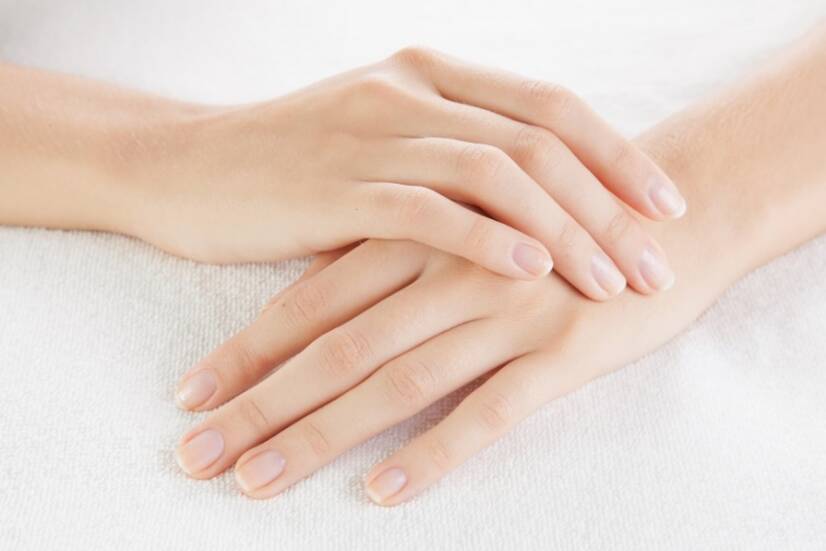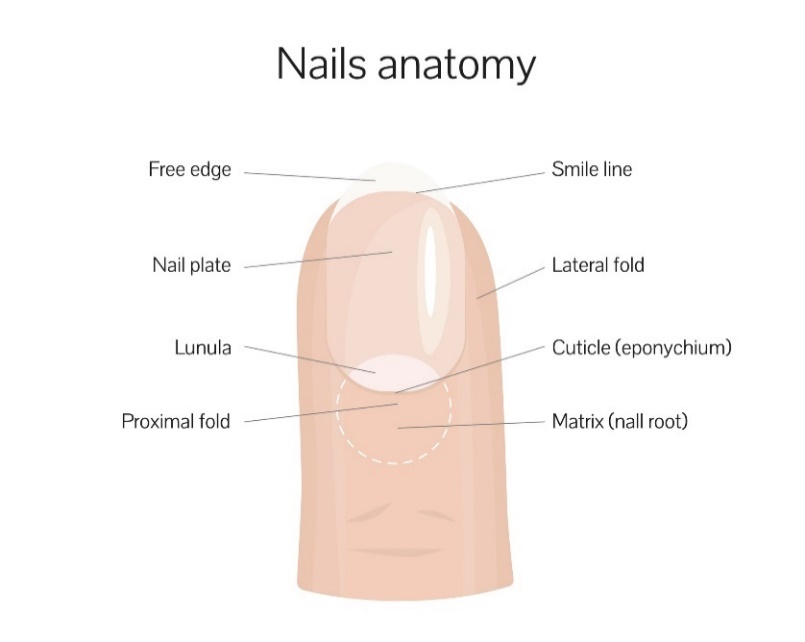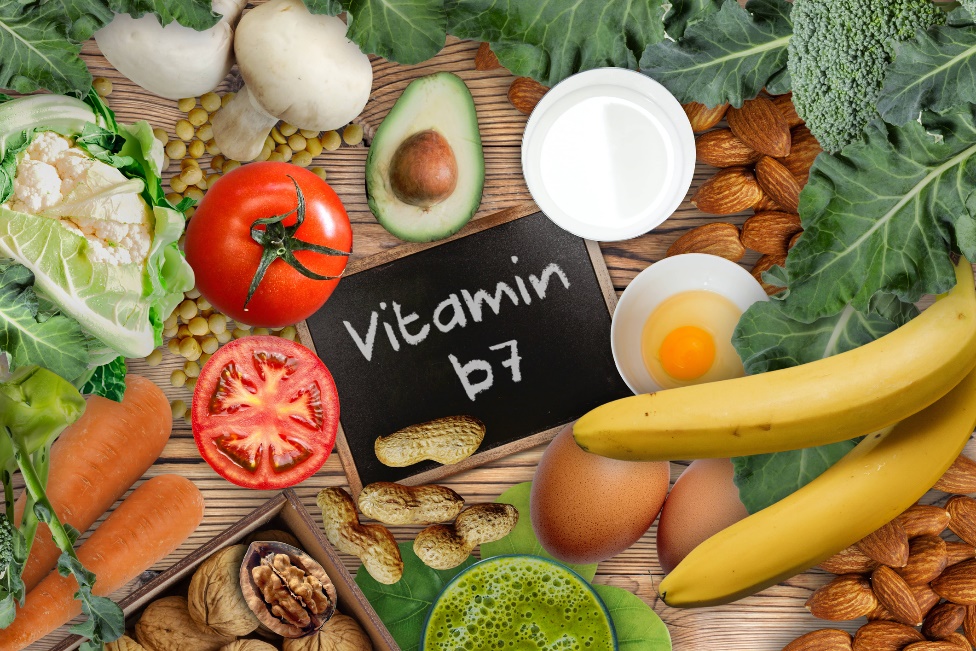- dermatologiepropraxi.cz - Diseases and pathologies of nails. Dermatology for practice. MUDr. Alena Štumpfová
- healthline.com - Tips for faster nail growth. Healthline. Debra Sullivan, Ph.D., MSN, R.N., CNE, COI
- solen.com - Diseases and pathologies of the nails. Solen. Alena Stumpf, M.D.
- medicalnewstoday.com - What do your nails say about your health? Medical News Today. Cynthia Cobb, DNP, APRN, WHNP-BC, FAANP
- RESL, Vladimíra. Dermatovenerology: a review of the most important findings and experiences for undergraduate and graduate students of non-medical disciplines. In Pilsen: University of West Bohemia, 2014. ISBN 978-80-261-0387-5.
Slow nail growth: what could be the cause? How to promote nail growth?

In most cases, slow nail growth does not necessarily indicate any serious disease. The rate of growth is individual and depends on many internal and external factors. What are the possible causes of slow nail growth?
The causes and etiology of slow nail growth, diagnosis, treatment, nail health and many other interesting information can be found in the article.
Nail growth
Fingernails grow approximately 3 millimeters per month. Toenails grow approximately 0.5 millimeters per month.
A person's fingernails grow relatively slowly.
It can take up to 6 months for a fingernail to grow to its full length. It can take up to 12 months for a toenail to grow to its full length.
Toenails and little toes grow the slowest.
The length of nail growth varies individually and may not immediately indicate a serious disease.
Nail growth is influenced by a number of internal and external factors. An example is age. The older a person is, the slower the nails grow.
In addition to the overall health of the nail, the local health of the nail also affects the growth of the nail. Various defects, mechanical damage or diseases and infections can slow down the growth of the nail.
Factors affecting nail growth:
- Age
- General health and diagnoses
- Nail health (mycoses, defects...)
- Sufficient nutrients in the body (vitamins, minerals, proteins...)
- Pharmacotherapy (drugs and medicines used)
- Lifestyle (diet, stress factor)
- Pregnancy in a woman
- Seasons and climate
- Nail care
A healthy human nail consists of the nail matrix (root), lunula (light-coloured crescent), cuticle (nail cuticle), nail bed and nail plate.
The nail is a relatively hard keratin plate covering the ends of the fingers and toes. The nail matrix is the important part extending from the root of the nail bed to the lunula - the pale crescent. It is the part responsible for the formation and growth of the nail plate.
The nail bed, which is located below the nail plate, is richly vascularised. That is why it is coloured pink.

Causes of slow nail growth
The etiology of slow nail growth is quite diverse. Both internal and external factors play a role.
In some cases, a slight slowdown in nail growth can be physiological. This is, for example, the period of pregnancy or the cold winter time of the year.
During pregnancy, the body may be deficient in certain nutrients that are currently being used by other tissues of the body.
A common reason for this is an inappropriate lifestyle in terms of inadequate nutrient intake and excessive stress. Conversely, in some cases, cardiovascular, dermatological and other diseases may be involved.
Lack of nutrients in the body
Slower nail growth is particularly evident when there is a deficiency of certain micronutrients. Among the minerals, these are mainly calcium, zinc, iron and silicon. Important vitamins for the nails include vitamin A, vitamin B complex and vitamin C.
Vitamins D, E and vitamin B7 (biotin) are also important.
Adequate macronutrients and protein in the diet are also necessary for nail nutrition. Collagen and keratin are proteins that play an important role in the growth and quality of nails and hair.
When there is a lack of protein in the diet, it is possible to experience a deterioration in the quality of hair, skin and nails.
Keratin is a protein found in humans primarily in hair, skin, nails and to a lesser extent in other tissues. Collagen is a protein found in skin, hair, nails, musculoskeletal and connective tissues.
The human body breaks down ingested proteins into individual amino acids. These are sent to target tissues to make the specific protein the body needs.
Protein is an essential building block of tissues, so adequate intake is important.
Interesting information also in the article:
How protein benefits skin health + What does protein contain?
Inappropriate lifestyle and nail care
Slow nail growth can be the result of frequent chronic stress. The nutrition of the nail plate is thus impaired due to vascular and nerve overload. The stress factor can affect not only the nails, but also the hair or skin.
An unhealthy lifestyle is associated with an insufficiently balanced and wholesome diet. With a low intake of vitamins, minerals and proteins in the diet, deficiencies can be noted on skin derivatives.
Nail care also plays a role in growth. Hand hygiene, regular gentle trimming, filing of sharp edges and prevention of mechanical damage (breaking, tearing, splitting) are essential.
Intermittent moisturisation and nourishment with suitable non-irritating cosmetic products is recommended.
A common cause of nail disruption is mechanical damage (nail biting, inadequate manicure, microtrauma, injury during sport or work, etc.).
Local nail diseases
A common cause of discoloration and texture is just fungal or fungal and bacterial nail disease.
Mycotic disease occurs mainly on the toenails, as the heat and humidity in the shoe is an ideal environment for fungi. Yeast, on the other hand, mainly affects the fingernails.
The most common nail disease is onychomycosis, which is mainly caused by fungi parasitic on the keratin of the nail. Yeasts, dermatophytes or micromycetes are responsible for the occurrence.
In these mycotic diseases, the nails may be soft, discoloured, thickened and deformed.
Peeling nails, discoloration, the presence of color spots and other pathological manifestations should be consulted with a dermatovenerologist.
Cardiovascular diseases
Slow nail growth can be noted in patients with certain cardiovascular diseases. The main cause is ischemic lower extremity disease (IHDD), which occurs mainly in the elderly.
Peripheral arterial disease: what are its causes and symptoms + prevention
The underlying cause of this disease is atherosclerosis, and therefore the deposition of fat in the walls of the arteries, which in turn leads to a constriction of blood flow.
This results in leg pain, neuromuscular problems, deterioration of the skin and nails. The muscles of the limbs are weaker, the skin is drier and the nails grow more slowly with a tendency to brittleness and fragility.
This also applies to other diseases that cause inadequate blood supply to the lower or upper limbs, such as anaemia.
Other physical ailments
Alteration of the nails and hair is common in patients with weakened immune systems and autoimmune diseases. The presence of weak brittle nails with deformation or discoloration is possible.
Problems with slow nail growth can also occur with metabolic and endocrine diseases. An example is hypothyroidism, when the thyroid gland produces a lack of necessary hormones.
The lack of hormones can result in reduced nail quality.
Problems with nail quality can also occur with diabetes mellitus, thyroid hypofunction, hormonal imbalance or rheumatoid arthritis.
Brittle weak nails can be a sign of digestive tract diseases, digestive disorders and nutrient absorption into the body.
The presence of a strong bacteria (infection) in the body that invades various tissues of the body can also slow down growth and nails.
Diagnosis and treatment of slow nail growth
Treatment of slow nail growth depends on the etiology and the exact cause. The area of nails and skin derivatives is dealt with by a dermatovenerologist.
On examination, the doctor may biopsy (scrape) the nail for mycological analysis to rule out or determine the presence of infection.
In the case of mycotic nail disease, an antifungal topical ointment is indicated for the patient. Alternatively, total oral antifungal therapy.
If this is the result of a deficiency of nutrients (vitamins, minerals or protein) in the body, dietary modification is necessary.
It is also possible to supplement with nutritional supplements to support nail health. Most of these are combined as dietary supplements for hair, nail and skin health.
The key is a complete balanced diet. In relation to nail health, the intake of protein, zinc, selenium, vitamin B and C is important.
To support the quality of the nails, it is possible to reach for supportive topical medications or cosmetic supplements (ointment, cream, varnish).
Some cosmetic products contain nutrients and proteins that stimulate the nail plate. It is advisable to consult a doctor, especially in the case of nail infections.
Therapy of slow nail growth due to more serious diseases consists in the treatment of the disease in question. For example, in ischemic disease of the lower extremities, this involves pharmacological treatment of blood clotting, blood pressure, etc.
For diseases of other internal systems, the patient is referred to the appropriate department.
When to see a doctor?
Significantly slow nail growth should not be overlooked. It may not be a serious health problem. But with a change in nail growth, it is advisable to have a doctor make the diagnosis.
For acute or prolonged changes in nail structure, see a dermatologist.
If you are experiencing other general physical symptoms, it is advisable to see a GP who will then refer you to the appropriate department.
Prevention of healthy nails:
- A nutritionally balanced diet
- Enough zinc, selenium, silicon, calcium and iron
- Sufficient vitamins A, C, D, E and B-complex
- Adequate dietary protein intake
- Regular gentle manicures and pedicures
- Disinfection of used cosmetic instruments
- Hygiene as infection prevention
- Limiting irritating cosmetic products and adhesives
- Reduction of products containing acetone
- Use of primer before painting
- Support and nourishment of nails with proven products
- Regular visits to the dermatologist
- Protection from hazardous manual activities

Diseases with symptom "Slow nail growth"
Interesting resources
Related










